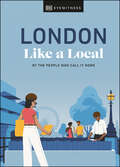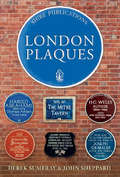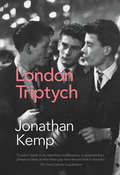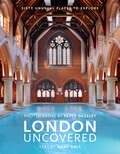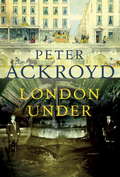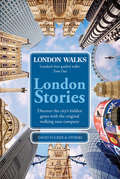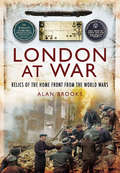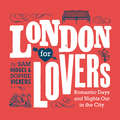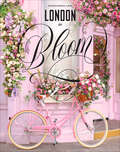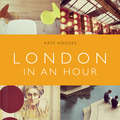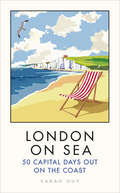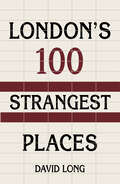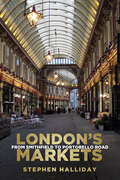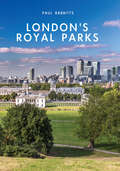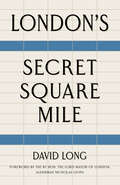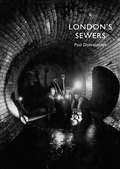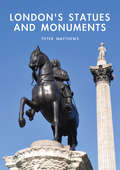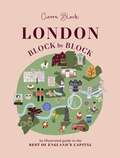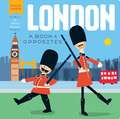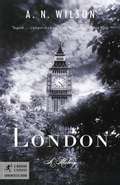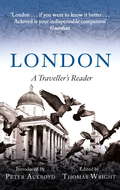- Table View
- List View
London For Dogs: A dog-friendly guide to the best of the city
by Sarah GuyLondon for Dogs features over 120 ideas for things to do with your dog in the city. Organised around each borough from North to South, East to West, there’s something to discover whether you want to be surprised by a gem just round the corner or fancy exploring somewhere further afield. Including pubs, cafes and restaurants that welcome dogs with enthusiasm; find the best places to enjoy a quiet hour or meet up with friends, and maybe even discover your new local. As well as London’s more obvious green spaces, this guide will also highlight unsung parks, such as the lovely Hilly Fields in South East London. There’ll also be suggestions of weekend activities such as the Lee Valley dog agility course, which includes jumps, hoops and a high walk. For less energetic things to do on the weekends, the guide will also cover behaviourists, groomers and quirky dog boutiques where you can treat your pooch to everything from handmade treats to tweed dog collars. Looking to escape city life for a day? The guide also includes inspiration for short trips away, as well as top ten lists for those pushed for time. Whether you’re a resident Londoner looking for new dog-friendly inspiration, or a visitor hoping to navigate the city with your four-legged friend, London for Dogs will transform your experience of London.Featuring contributions from journalist and broadcaster Kate Spicer, food writer Debora Robertson and founder of Lily's Kitchen Pet Food, Henrietta Morrison.
London Like a Local: By the People Who Call It Home (Local Travel Guide)
by Florence Derrick Marlene Landu Olivia PassKeen to explore a different side of London? Like a Local is the book for you.This isn&’t your ordinary travel guide. You won&’t find the London Eye or Buckingham Palace in these pages, because that&’s not where Londoners hang out. Instead, you&’ll meet the locals at hidden record shops, cosy pubs and indie galleries – and that&’s where this book takes you. Turn the pages to discover: The small businesses and community strongholds that add character to this vibrant city, recommended by true locals.6 themed walking tours dedicated to specific experiences such as street art and brewing history.A beautiful gift book for anyone seeking to explore London.Helpful &‘what3word&’ addresses, so you can pinpoint all the listed sights.A thoughtfully updated second edition, including new sights to discover.Compiled by three proud Londoners and revised and updated for 2023, this stylish travel guide is packed with London&’s best experiences and secret spots, handily categorized to suit your mood and needs.Whether you&’re a restless Londoner on the hunt for a new hangout, or a visitor keen to discover a side you won&’t find in traditional guidebooks, London Like A Local will give you all the inspiration you need. About Like A Local:These giftable and collectible guides from DK Eyewitness are compiled exclusively by locals. Whether they&’re born-and-bred or moved to study and never looked back, our experts shine a light on what it means to be a local: pride for their city, community spirit and local expertise. Like a Local will inspire readers to celebrate the secret as well as the iconic – just like the locals who call the city home. Looking for another guide to London? Explore further with our DK Eyewitness or Top 10 guides to London.
London Night and Day, 1951
by Old House BooksThis unusual and entertaining guide to the capital gives a snapshot of the best places to visit. Arranged by hour of the day, it takes the reader on a journey around 1950s London, from your morning walk to your visit to the Turkish Bath and late-night taxi home. Includes recommended restaurants (many of which still exist), the best stately homes to visit, a tour of the Thames and how to cope with the noise and dirt of a trip to the capital.
London Plaques
by Derek SumerayThe city of London is dotted with plaques, many of them blue, all commemorating either a famous person who was born, lived, or stayed in that building, or sometimes a significant event that took place, or an earlier use of the site.This book is a comprehensive gazetteer of all of London¿s plaques. Using Derek Sumeray's classic book as a basis, this thoroughly revised new edition arranges plaques alphabetically by area, providing a text that is linked to London's geography and, therefore, of greater use to a resident or visitor wanting to explore the famous people and events commemorated in that area. Illustrated with photographs of many of the plaques and the places, this is the only guide to all the commemorative plaques in Greater London.
London Triptych
by Jonathan Kemp"London itself is as powerful a presence here as the three gay men whose lives it absorbs."?The Times Literary Supplement"Vivid and visceral, London Triptych cuts deep to reveal the hidden layers of a secret history."?Jake Arnott, author of The Long FirmRent boys, aristocrats, artists, and criminals populate this sweeping novel in which author Jonathan Kemp skillfully interweaves the lives and loves of three very different men in gay London across the decades.In the 1890s, a young man named Jack apprentices as a rent boy and discovers a life of pleasure and excess that leads to new friendships, most notably with the soon-to-be-infamous Oscar Wilde. A century later in 1998, David tells his own tale of unashamed decadence from prison, recalling life as a young man arriving in the city in the mid-'80s just as the scourge of AIDS hit. Where their paths cross, in the politically sensitive 1950s, when gay men were the target of police and politicians alike, the artist Colin tentatively explores his sexuality while working on his painting "London Triptych."Moodily atmospheric and rich with history, London Triptych is a sexy, resplendent portrait of the politics and pleasures of queer life in one of the world's most fascinating cities.Jonathan Kemp lives in London, where he currently teaches creative writing at Birkbeck College. London Triptych, his first novel, was published in the United Kingdom in 2010 and won the Authors' Club Best First Novel Award.
London Uncovered: Sixty Unusual Places to Explore (Unseen London Ser.)
by Mark DalyFilled with stunning color photos, a unique guidebook that opens the doors to sixty of London’s most intriguing lesser-known places: “A joy.” —Evening StandardFrom museums and places of worship to some of the most historic and ornate shops, houses, and hostelries, take a trip through the city’s hidden treasures and discover landmarks strange, gaudy, grand, and inventive. Describing the history and character of each place, this book uncovers a wealth of stories about an endlessly fascinating world capital. Discover:Historical Homes like the Charles Dickens Museum, Strawberry Hill House, and Kew Palace and the Royal Botanical GardensFood and Drink Spots like Ye Olde Cheshire Cheese, Smithfield Meat Market, and The Black FriarPalaces of Entertainment such as The Rivoli Ballroom, The All England Lawn Tennis and Croquet Club, and Gala Bingo Hall TootingPlaces of Worship including Westminster Cathedral, Welsh Baptist Chapel, Bevis Marks Synagogue, and Peace Pagoda Battersea ParkRemarkable Shops like LassCo Salvage, Truefitt and Hill, Steinway & Sons, and The Roof Gardens in KensingtonScience and Education Attractions like Kempton Steam Museum, Alexander Fleming Laboratory Museum, Old Operating Theatre Museum and Herb Garret, and Royal Institution of Great BritainInns of Court from The Honourable Society of Gray’s Inn to the Temple ChurchUnusual Museums including The Royal Airforce Museum, Churchill Museum and Cabinet War Rooms, Geffrye Museum of the Home, Musical Museum, and Wimbledon WindmillPraise for Peter Dazeley and Mark Daly’s Unseen London“A thrilling tour behind the closed doors of the capital city’s buildings.” —Daily Telegraph“Dazeley captures the atmosphere of each building to perfection.” —Daily Express“Fascinating.” —Fabric magazine
London Under: The Secret History Beneath the Streets
by Peter AckroydLondon Under is a wonderful, atmospheric, imaginative, oozing short study of everything that goes on under London, from original springs and streams and Roman amphitheaters to Victorian sewers, gang hideouts, and modern tube stations. The depths below are hot, warmer than the surface, and this book tunnels down through the geological layers, meeting the creatures, real and fictional, that dwell in darkness--rats and eels, monsters and ghosts. When the Underground's Metropolitan Line was opened in 1864, the guards asked for permission to grow beards to protect themselves against the sulfurous fumes, and named their engines after tyrants--Czar, Kaiser, Mogul--and even Pluto, god of the underworld. To go under London is to penetrate history, to enter a hidden world. As Ackroyd puts it, "The vastness of the space, a second earth, elicits sensations of wonder and of terror. It partakes of myth and dream in equal measure."From the Hardcover edition.
London Walks: London Stories
by David TuckerLondon Walks is the award-winning original walking tour company. Written by the expert and knowledgeable guides who lead the walks, London Stories is the perfect way to discover the rich history of London and its hidden gems, including:Sinister London - haunted London and Jack the Ripper.Literary London - from Shakespeare to Dickens.Public Houses - the old pubs of Soho. Mystery and Secrets - the city's hidden past.A Tale of Two Cities - Westminster and the Square Mile.Perfect for tourists who want to experience London life beyond Trafalgar Square as well as for Londoners keen to step off the Circle Line and discover the secrets on their own doorstep, London Stories offers a fascinating glimpse into the capital's rich history. With photos, maps and illustrations to bring the stories to life, London Stories is for those who love London, written by those who know it best.
London and Paris Through Indian Spectacles
by G. Paramaswaran Pillai Usha SahanaThe book is structured in the form of a series of sketches, usually about people, and it is here that Piliai's powers of observation and human sympathy are most evident. Whether it is his landlady, a policeman, a bus driver, or a waiter, Pillai makes the individual as well as the institution come alive. There is also a wealth of sociological and historical detail which emerges from the travelogue.
London at War: Relics of the Home Front from the World Wars
by Alan BrooksAn extensively illustrated tour of relics and reminders of the city&’s WWI and WWII experiences. The two world wars of the twentieth century seem so distant from us now, yet in London the evidence of these conflicts can be found in the many relics and reminders that are scattered across the fabric of the modern city. And, as Alan Brooks demonstrates in this fascinating photographic record, they can be seen and visited today. Plaques and inscriptions, graves, cemeteries and rolls of honor, stone monuments and stained glass, war-damaged buildings, pillboxes, and air-raid shelters, painted signs and camouflage—these are just some of the mementos of war, and of the experience of Londoners during the greatest conflicts the country has known.
London for Lovers
by Sam Hodges Sophie VickersForget Paris – London is the city for lovers.London for Lovers navigates the changing face of the Capital, with all of its secrets and surprises, mapping out romantic dates full of originality, spontaneity, and adventure, allowing you to concentrate on the main event – each other.Whether your idea of a blissful date is walking with dinosaurs in Crystal Palace or star-gazing in Greenwich Park, sniffing out the best street eats in Maltby Street or unearthing Gothic romance in Highgate Cemetery - there are ideas here to suit every mood, every season and every budget. There are suggested routes for quiet days of romance in Leafy London - from Hampstead Heath and Kensington Gardens, to Isabella Plantation and St James Park, taking in some secret gardens on the way. Or for the night owls, Late Night London - from the Seven Noses of Soho to the streets of Shoreditch, from Dalston's hippest bars to Exmouth Market's Cafe Kick. And then there's Lost London, Last Minute London, Lazy London and Learned London, as well as Live and Left-field London.For first dates and soul mates, long term Londoners or just visiting, this book freewheels through London to find you a few hours that could change everything.
London in Bloom
by Georgianna LaneJoin acclaimed photographer Georgianna Lane and explore the flower markets, gardens, and floral boutiques of London in this full-color celebration of the flora of England’s capital. London in Bloom showcases the floral abundance of the city’s extraordinary parks, gardens, florists, and flower markets. In this companion to her popular books Paris in Bloom and New York in Bloom, Georgianna Lane takes us on a romantic floral tour of London, juxtaposing luscious blooms with intricate floral details found in iconic architecture. The book also includes: A detailed list of recommended parks, gardens, markets, and floral designers A spring tour of blossoms and blooms A field guide of common spring-blooming trees and shrubs Step-by-step instructions for creating a London-style bouquet And more Lane offers a practical travel guide for anyone planning to see London in bloom in real life. She plans out a tour of spring blossoms, with a field guide for identifying flowering trees and shrubs. She even includes a list of addresses for her favorite parks, gardens, floral boutiques, and flower markets. Lane writes, “No place, real or imagined, enchants quite like an English garden. The ornate gates, the tumbling roses, the winding paths, and the sunlight winking through branches of delicate blossoms have long inspired poetry and romance. . . . Some are intimate and secret, with secluded corners and mysterious pools where dragonflies hover or fantastic creatures might even dwell. Others are impressive and majestic, their rolling parklands reminiscent of an eighteenth-century landscape painting.” For flower lovers and Anglophiles alike, London in Bloom offers a unique and irresistible view of London, a chance to bring “poetry and romance” to your home or to give it as a gift.
London in an Hour
by Kate HodgesFeatures 120 bite-size ideas for things to do and places to visit in London in under an hour. Organised around the range of activities London has to offer, with chapters to help you find original and diverting suggestions for things to do, as well as a few places to eat and drink. Including how to squeeze in some culture or some exercise; find the best places to buy a birthday present or go for a quick pampering; discover outdoor spaces or quiet hideaways to escape the chaos; avoid the typical al desco lunch; make the most of your mornings; and turn a spare hour in-between a meeting or at a train station into an hour well spent. Will also include top ten lists for those really pushed for time and comprehensive indices by location and activity type to help you find what you need, quickly. Whether you’re a visitor, on a family day out or a busy working Londoner, London in an Hour will transform your experience of the city.
London's 100 Strangest Places: London's 100 Strangest Places
by David LongThe bustling metropolis of London is home to scores of unusual and unique places and spaces. In this feast of peculiarities, author David Long guides you off the beaten path and allows you under the skin of the hidden city that is modern-day London, revealing a new side to the capital you thought you knew.
London's Markets: From Smithfield to Portobello Road
by Stephen HallidayLondon is a City of Markets: markets in meat, fish, fruit, vegetables, money, insurance, shipping and, occasionally, in stolen goods. Stephen Halliday’s book is a comprehensive account of the often lurid and controversial history of its markets from Roman Londinium to the London of Boris Johnson as well as a guide to visiting them (and emerging with a bargain).
London's Royal Parks
by Paul RabbittsThis book tells the history of London's royal parks and how they have evolved from private hunting grounds and gardens into public spaces and venues for great events. In some cases, the parks were royally owned as long ago as the Norman conquest, and several of them were acquired by Henry VIII during the Reformation. At this time they were kept private and there was no public access, but during the eighteenth century most of the parks were opened to the public. Landscaping work was undertaken to keep up with trends, and the parks became fashionable places to be seen out and about - witness Rotten Row in Hyde Park. The parks, Hyde Park in particular, has been used to host major events such as the Great Exhibition and various jubilee and entertainment events. It tells the story of each of the nine royal parks from their acquisition by the monarchy through to the present day, outlining their use and management and the major historical moments associated with them.
London's Secret Square Mile: The Secret Alleys, Courts & Yards of London's Square Mile
by David Long William Russell Nicholas LyonsThe streetscape of London’s historic square mile has been evolving for centuries, but the City’s busy commercial heart still boasts an extensive network of narrow passages and alleyways, secret squares and half-hidden courtyards.Using his wealth of local knowledge, historian David Long guides you through these ancient rights of passage – many dating back to medieval times or earlier – their evocative names recalling old taverns, notable individuals and City traditions. Hidden behind the glass, steel and stone of London’s banks and big business, these survivors of modern development bear witness to nearly 2,000 years of British history.
London's Sewers
by Paul DobraszczykVictorian London was filthy. The city was growing at an exponential rate, and the existing systems of waste disposal could not cope, resulting in a sanitary crisis. The solution was a new drainage system for the entire city, which was constructed mainly in the 1860s. Paul Dobraszczyk charts the development and construction of this immense project, using both contemporary and modern imagery to illustrate the complex engineering and magnificent architecture built deep underground to service the modern city of London.
London's Statues and Monuments
by Peter MatthewsThe streets and public spaces of London are rich with statues and monuments commemorating the great people of history. From the monumental Nelson's Column in Trafalgar Square and Sir Christopher Wren's Great Fire Monument to the charming Peter Pan statue in Kensington Gardens, and the bronze of Paddington Bear on the lawn of the railway station that gave him his name, the range of London's statues and monuments is huge. Some commemorate events, while others celebrate people, real and fictional. Some take the form of small reliefs, while others are huge pedimented bronzes, larger than life size. Executed in stone, bronze and a range of other materials, London's statues and monuments include work by some of the greatest sculptors.Shire first published a book on this subject in 1968, and for forty years it was a stalwart of the list, opening the eyes of countless Londoners and visitors to the capital to the sculptural splendour of the city. Peter Matthews has now produced an entirely new book on the subject, reorganised, rewritten, and reillustrated with a completely new set of specially taken photographs. Over 500 statues and monuments feature in this indispensible guide, and fascinating information about the sculptors and the stories behind the monuments make this book a uniquely useful resource for anyone wanting to gain a deeper insight into these wonderful adornments to the streets of the capital.
London, Block by Block: An illustrated guide to the best of England’s capital (Block by Block)
by Cierra BlockFor anyone who loves London – whether you're visiting for the weekend or are a die-hard local – this is the book for you.Artist Cierra Block loves to create maps, and this compilation will have you uncovering the best things London has on offer. Featuring the most notable places to eat, what to see, where to walk and what to do, this is a guide like no other. Vibrantly illustrated, Cierra lists all the top addresses and areas to explore. Find out where to indulge in the best afternoon tea and festive mince pies; jump on a bike and take a spin around Shoreditch or Hampstead like a local; or follow in the footsteps of the Suffragettes. From haunted spots for true-crime lovers, to the best bookshops, romantic strolls and coffee pit-stops, London, Block by Block will make your next visit to London the most memorable one yet.
London: A Book of Opposites (Hello, World)
by Ashley EvansonHello, World is an exciting book series that pairs early learning concepts with colorful, stylish illustrations of cities around the world. London can be rainy, or it can be sunny. Some Buckingham Palace guards are big, and others are little. Explore opposites through the sights of London in this gorgeous book!
London: A History
by A. N. WilsonIn its two thousand years of history, London has ruled a rainy island and a globe-spanning empire, it has endured plague and fire and bombing, it has nurtured and destroyed poets and kings, revolutionaries and financiers, geniuses and visionaries of every stripe. To distill the magic and the majesty of this infinitely enthralling city into a single brief volume would seem an impossible task--yet acclaimed biographer and novelist A. N. Wilson brilliantly accomplishes it in London: A History. Founded by the Romans, London was a flourishing provincial capital before falling into ruin with the rest of the Roman Empire. Centuries passed before the city rose to prominence once again when William the Conqueror chose to be crowned king in Westminster Abbey. In Chaucer's day, London Bridge opened the way for expansion over the Thames. By the time Shakespeare's plays were being mounted at the Globe, London was a dense, seething, and explosively growing metropolis-a city of brothels and taverns and delicate new palaces and pleasure gardens. With deftly sketched vignettes and memorable portraits in miniature, Wilson conjures up the essence of London through the ages--high finance and gambling during the Georgian age, John Nash's stunning urban makeover at the dawn of the Industrial Revolution, the waves of building and immigration that transformed London beyond recognition during the reign of Queen Victoria, the devastation of the two world wars, the painful and corrupt postwar rebuilding effort, and finally the glamorous, polyglot, expensive, and sometimes ridiculous London of today. Every age had its heroes and villains, from church builder Christopher Wren to jail breaker Jack Sheppard, from urbane wit Samuel Johnson to wartime prime minister Winston Churchill, and Wilson places each one in the drama of London's history. Exuberant, opinionated, surprising, often funny, A. N. Wilson's London is the perfect match of author and subject. In a one short irresistible volume, Wilson gives us the essence of the people, the architecture, the intrigue, the art and literature and history that make London one of the most fascinating cities in the world.
London: A Traveller's Reader (A Traveller's Companion)
by Thomas Wright Peter AckroydLoved and hated in equal measure, London was for centuries the world's greatest city. Its streets, teeming with history, have always worn a variety of influences, reflecting the diverse crowds who have walked them. Its citizens have witnessed everything from pilgrimages, celebrations, acts of heroism and moments of religious contemplation to riots, executions, grisly murders and disastrous plagues and fires. Drawing on letters, diaries and memoirs of London's most interesting inhabitants and visitors, this anthology compiled by acclaimed historian Thomas Wright and with an introduction by Peter Ackroyd tells the story of the city from its earliest years.Here you will find John Evelyn's famous account of the Great Fire in 1666, Dickens's brilliant evocation of the Gordon Riots of 1780, an eyewitness description of the execution of Charles I, and Churchill's recollections of the Blitz. There are also less familiar, though no less vivid, excerpts, which provide an entertaining, sometimes risqué glimpse into the life, customs and morals of this great city.
London: A Traveller?'s Reader Epub
by Thomas Wright Peter AckroydLoved and hated in equal measure, London was for centuries the world's greatest city. Its streets, teeming with history, have always worn a variety of influences, reflecting the diverse crowds who have walked them. Its citizens have witnessed everything from pilgrimages, celebrations, acts of heroism and moments of religious contemplation to riots, executions, grisly murders and disastrous plagues and fires. Drawing on letters, diaries and memoirs of London's most interesting inhabitants and visitors, this anthology compiled by acclaimed historian Thomas Wright and with an introduction by Peter Ackroyd tells the story of the city from its earliest years.Here you will find John Evelyn's famous account of the Great Fire in 1666, Dickens's brilliant evocation of the Gordon Riots of 1780, an eyewitness description of the execution of Charles I, and Churchill's recollections of the Blitz. There are also less familiar, though no less vivid, excerpts, which provide an entertaining, sometimes risqué glimpse into the life, customs and morals of this great city.

